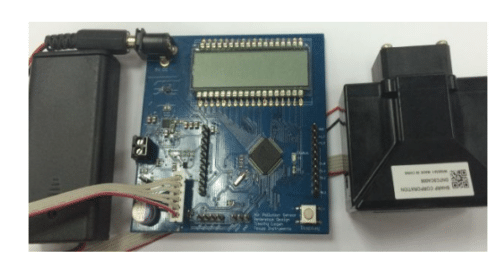Explore this cutting-edge device’s key features and benefits, including its ultra-low-power operation, integrated LCD display, and comprehensive testing and documentation.

Air quality and its effects on health and vitality have recently become a much-talked-about topic. Higher levels of air pollution have been linked to detrimental health effects and adverse implications on quality of life. The golden standard of measuring the level of air pollution is the Air Quality Index (AQI). Applications for this device include air purifiers, weather stations, industrial systems, and air conditioner systems.
This reference design TIDM-AIRQUALITYSENSOR by Texas Instruments features a simple air quality monitor implemented using the particulate matter 2.5 level. It utilises the MSP430FR4133 microcontroller (MCU) and Sharp DN7C3CA006 PM2.5 sensor. The ultra-low-power design of the MSP430 MCU, coupled with DN7C3CA006’s integrated analog, works in tandem to capture air samples and calculate the air quality index (AQI). From periodic PM2.5 samples, the AQI is calculated and displayed using an 8-character, 14-segment LCD.
Key features of the device include the ability to calculate PM2.5 concentration levels and AQI levels, as well as temperature and humidity levels. It includes an 8-character, 14-segment LCD to display calculation results. Powered by an ultra-low-power MSP430FR4133 MCU, it boasts an integrated LCD controller for efficient operation. TI built the system design to be affordable and flexible. Close scrutiny and great effort were placed into selecting the optimal sensor to calculate the AQI and PM2.5 level. While many sensors can measure particulate matter concentration, the Sharp DN7C3CA006 sensor can measure to a μg/m³ level. Calculating down to the µg/m³ level allows for an accurate calculation of a PM2.5 level rather than a less accurate PM10 level. The measured PM2.5 level is plugged into a specialized equation provided by the USEPA, and the AQI is calculated.
In addition to PM2.5 and AQI, the integrated TI HDC1000 is used to calculate humidity and temperature. TI chose the MSP430FR4133 MCU due to its low-power operation and integrated segment LCD peripheral. Virtually every peripheral of the MSP430 is used in this design to foster a complete and optimized architecture. One of the critical advantages of using the MSP430 is the highly configurable and integrated LCD module. Because an 8-character Varitronix VIM-878 segment LCD is used, a microcontroller with 36 LCD I/Os is required. Additionally, the ability of the MSP430 to pragmatically configure which LCD pins are used for SEG lines and which pins are used for COM lines made layout of this design easy.
Texas Instruments has thoroughly tested this reference design, which includes a Design Guide, Bill of Materials (BOM), schematics, Gerber files, Printed Circuit Board (PCB) layout, and more. Please visit the company’s website for further information on this reference design. To explore this design in greater detail, click here.






